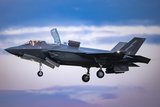Sentient and Shield AI sign agreement to integrate next generation ViDAR onto V-Bat
V-Bat has been in service in Brazil and has been evaluated by Canada. (Photo: Shield AI)
Australia’s Sentient Vision and US-based Shield AI will develop a next-generation wide-area motion imagery (WAMI) solution which will see Sentient’s ViDAR system integrated onto the US company’s V-Bat VTOL UAS under an agreement signed on 23 October.
The multi-year, multi-unit agreement will lead to deliveries beginning next year. It follows a previous joint development announcement over the integration of a ViDAR-enabled, wide-area-search capability onto Shield AI’s V-Bat unmanned aircraft, which has enabled Shield AI’s V-Bat to intelligently classify, track and read-and-react to targets in dynamic missions.
According to the companies, the agreement reflected a wider strategic objective within the tri-nation AUKUS agreement, particularly as it relates to the field of AI.
Sentient CEO Mark Palmer said: ‘The confirmation of our long-term relationship absolutely reflects the AI technology workstream that is underlined in the AUKUS Pillar 2. Innovation stemmed from our computer vision AI-enabled ViDAR and Shield AI’s Hivemind will provide commanders with immediate situational awareness and survivability of our warfighters.’
ViDAR, Sentient’s AI system, uses an EO/IR sensor to detect and classify targets in the imagery stream that would be invisible to a human operator or to a conventional radar.
Related Equipment in Defence Insight
More from Air Warfare
-
![Boeing to build Apache AH-64E attack helicopters for Poland, Egypt and Kuwait]()
Boeing to build Apache AH-64E attack helicopters for Poland, Egypt and Kuwait
The $4.7 billion international order for the three countries will see production conclude around May 2032.
-
![F-35B delivery date slips to 2026, UK MoD confirms]()
F-35B delivery date slips to 2026, UK MoD confirms
The UK was originally set to receive all remaining aircraft by the end of 2025, although the MoD had previously forecast that deliveries could be delayed until April 2026.
-
![Lockheed assesses possible engine options for Vectis CCA development]()
Lockheed assesses possible engine options for Vectis CCA development
The Collaborative Combat Aircraft (CCA) was unveiled in September, with Lockheed pursing an accelerated roadmap to first flight in 2027.





















